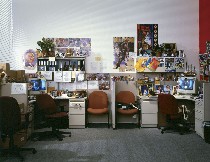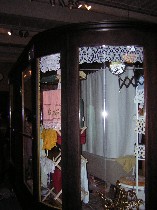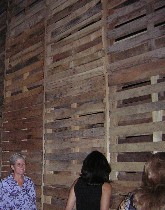Post by Colette Copeland
 “Trials & Turbulence”–Pepon Osorio’s new installation at the ICA–explores the fractured intersection between the private sector and government agencies.
“Trials & Turbulence”–Pepon Osorio’s new installation at the ICA–explores the fractured intersection between the private sector and government agencies.Osorio participated in a three-year residency with the Department of Human Services, working with social workers and administrators focusing on the foster care programs. Creating large-scale environmental tableaux, Osorio transforms the ICA galleries to resemble DHS office cubicles (image above), and a family courtroom. As in the artist’s previous work, Osorio fuses community and art, questioning the role of both art and artist (see Libby’s take on Osorio’s installation here).
The tableaux overwhelm the viewer with found objects, photographs and artifacts, depicting the personalities/identities of the employees. The architecture repeatedly suggests containment/imprisonment.
The room’s center contains a large meshed wire receptacle, stacked with furniture and personal effects taken from DHS’s storage facilities. The accumulated remains trigger a feeling of claustrophobia in the space.
 The second room features a courtroom complete with faux stone, red curtains, witness stand and judge’s bench. Enclosed in the courtroom’s center is a glass vessel containing another tableau of a bathroom strewn with Barbie dolls, and toiletry items (image left).
The second room features a courtroom complete with faux stone, red curtains, witness stand and judge’s bench. Enclosed in the courtroom’s center is a glass vessel containing another tableau of a bathroom strewn with Barbie dolls, and toiletry items (image left).
Osorio utilizes video strategically throughout the space. The videos activate the architecture with a sense of life. Without the human presence, the installation remains static and dead–a Memento Mori, with the objects representing the people.
Each of the cubicles displays a video of a female child shaking her head in a repetitive gesture. The blurred image evokes beauty, while the gesture reveals a disturbing/manic tension. The disembodied, yet ethereal head floating on the computer screen, is the ghost of children past, present and future. In a conference room/holding cell, a video portraying a man performing the same repetitive gesture as the small girl, references the breakdown/failure of the government system.
Projected onto a window shade above one of the cubicles, is a video of a worker asleep at her desk. The poignant image speaks to the frustration and emotional exhaustion of the job.
Buried inside the wire receptacle amongst the abandoned belongings, an old TV displays interviews with social workers and employees speaking about their experiences.
 Dividing the cubicle from the courtroom is a wall of wooden boards blocking entrance into a darkened room (image right). Viewers are able to peek through the slats, glimpsing a wall-size projection of a boy running away. Like the looped videos of the young girl and man, this video is abstracted with the identity blurred, alluding to the many people whose lives are affected by the system.
Dividing the cubicle from the courtroom is a wall of wooden boards blocking entrance into a darkened room (image right). Viewers are able to peek through the slats, glimpsing a wall-size projection of a boy running away. Like the looped videos of the young girl and man, this video is abstracted with the identity blurred, alluding to the many people whose lives are affected by the system.The courtroom features two additional videos. In the glass vessel, projected onto a shower curtain, a young woman speaks about her experiences in many different foster homes. Visible from the front and behind (reflected into the medicine cabinet mirror), this video is particularly powerful. Osorio effectively addresses issues of public vs. private space. We become the woman’s confidantes, simultaneously in the privacy of her bathroom and the public space of the courtroom. The other video resides on the judge’s podium and shows hands slowly turning pages in a dictionary. The place where the gavel hits the desk, contains an image of a child’s hand.
Pepon Osorio’s complex installation asks us to question how art functions in our society and the role of the artist as a member of the community. By revealing the humanity within the public sector, Osorio’s work critiques the effectiveness of our social service agencies and asks us to look at those whose lives slip between the cracks.
—Colette Copeland makes videos and installations









